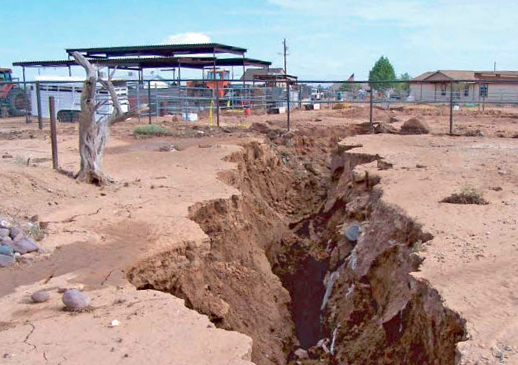Arizona Sinkholes: Disclosure & Liability
As recently reported on azcentral.com, a study by ASU’s School of Earth and Space Exploration shows that parts of Apache Junction, Sun City West, Peoria, the North Valley, Tucson, Casa Grande and Eloy are at risk of developing sinkholes.
Scientists at the school blame large amounts of groundwater that was pumped years ago and report it “has the potential to cause costly structural damages,” according to ASU researcher Megan Miller.
Anne Ryman at The Arizona Republic reports that if this trend continues, fissures (crack in the ground) will develop and threaten canals, utility lines, water mains, storm drains and sewers. The foundations of homes and buildings can be damaged as ground levels drop.
Ryman went on to write that fissures have been reported in places including…Queen Creek, Chandler and Scottsdale. Some Valley homeowners have even filed claims and lawsuits against real-estate agents and builders, hoping to be compensated for property damage from fissures they say they weren’t told about.
Which leads us to the Residential Seller’s Property Disclosure Statement (SPDS) that asks the seller whether they are aware of any past or present issues or problems on or in close proximity to the property related to fissures (lines 190-196). The SPDS continues with a notice to the buyer that the Arizona Department of Real Estate (ADRE) provides fissure maps on its website.

Pursuant to A.R.S. § 32-2117, a subdivider, seller or real estate licensee is not liable for any act or failure to act in connection with the disclosure of property subject to earth fissures if they provide a written disclosure or include notice in a public report, with respect to real estate subject to earth fissures, of the Arizona Geological Survey (AGS) map and its location.
Fissures, as addressed on page seven of the Arizona Association of REALTORS® Buyer Advisory, are open surface fractures and have been mapped by the AGS since the 1990s, but the Arizona Department of Water Resources says land subsidence has been happening here since the early 1900s.
DISCLOSURE NOTE: Land subsidence happens quite slowly, maybe three-quarters of an inch per year, and in isolated areas. In many instances, subsidence will go unnoticed and cause no harm or property damage. In fact, most houses experience some degree of settlement, which is the downward movement of a building (or building components) to a point below its original position.
In some cases, land subsidence may result in structural damage, often evidenced by cracks in walls and operational problems with windows and doors. In this event, a seller should remember their duty to disclose known facts materially affecting the value of the property that are not readily observable and are not known to the buyer. See Hill v. Jones, 151 Ariz. 81, 725 P.2d 1115 (App. 1986).
One way for a seller to meet their disclosure obligation in this regard is by accurately completing line 74 of the SPDS which asks, “Are you aware of any cracks or settling involving the foundation, exterior walls or slab?” If it has been disclosed that the property is subject to any such soil conditions, or if the buyer has any concerns about the soil condition or observes evidence of cracking, the buyer should secure an independent assessment of the property and its structural integrity by a professional engineer.
See also Suggested Guidelines for Investigating Land Subsidence and Earth Fissure Hazards in Arizona.